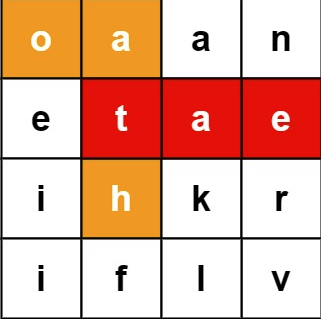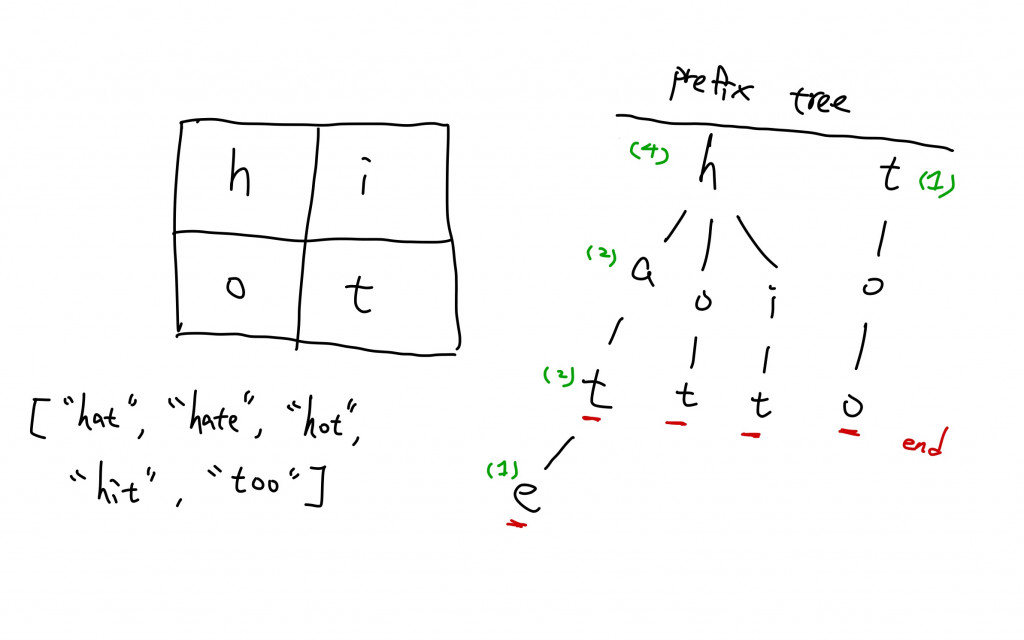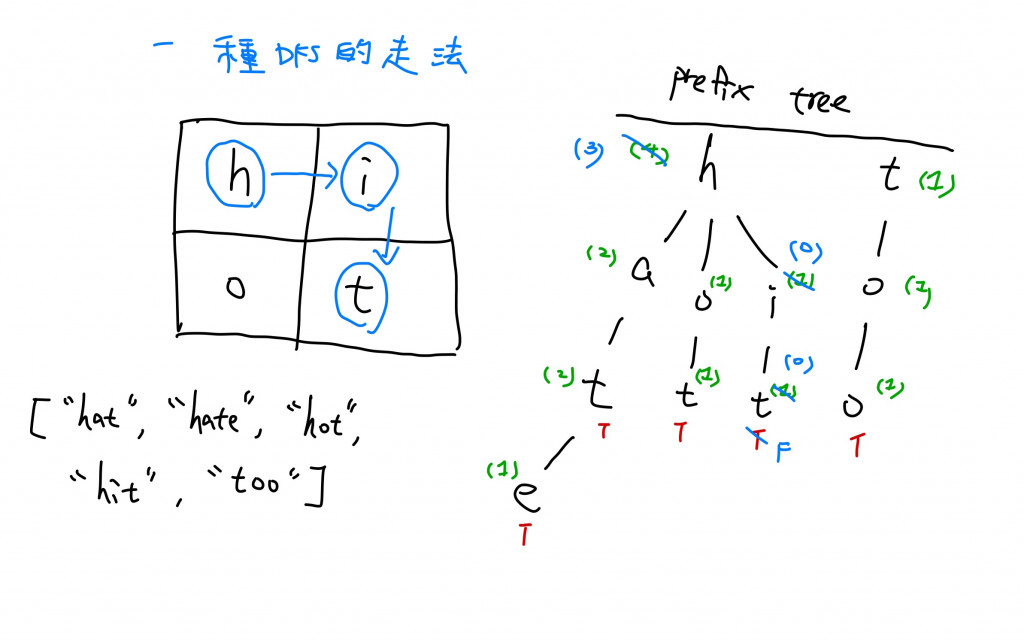大家好,今天要來分享Trie的進階題。
題目敘述:
有一個m x n的二維陣列,裡面存放了字元,另外又給予一個裝有數個字串的list,從二維陣列中找出所有包含在list中的字串。
Example1:
(圖源:leetcode)
Input: board = [["o","a","a","n"],["e","t","a","e"],["i","h","k","r"],["i","f","l","v"]], words = ["oath","pea","eat","rain"]
Output: ["eat","oath"]
分析:
我們可以利用DFS去拜訪二維陣列中的cell,比如說從左上角的"o"開始拜訪,接下來可以拜訪他的下方就讓拜訪的字串變成"oe"或是往右邊拜訪變成"oa",這樣子得到的字串我們可以拿去和list中的每一個字串(["oath","pea","eat","rain"])的前幾個字比較,然後發現往下走沒有符合的,所以往右走才有繼續比較的可能性。也就是說這是一個Back tracking的問題,我們需要去紀錄哪種走法所得到的字元排列出來會符合list中的字串。
但是比較字串的方法如果以上述來說可以有更優雅的方法,就是將list中的字串以Trie的方式儲存,因為這些拜訪了字元所組成的字串可以視為某些字串的prefix的可能。同時會紀錄哪些Trie節點被共用了幾次:
紀錄節點被使用了幾次是因為在Backtracking時,我們如果在二維陣列上找到了某個符合的字串,要將這個字串(path)上的所有node的「使用次數都分別減一」。當某個節點的次數少於1時,代表包含這個節點所組成的字串已經全部找到,不用再找了。
class TrieNode:
def __init__(self):
self.children = {}
self.isWord = False
self.refs = 0
def addWord(self, word):
cur = self
cur.refs += 1
for c in word:
if c not in cur.children:
cur.children[c] = TrieNode()
cur = cur.children[c]
cur.refs += 1
cur.isWord = True
def removeWord(self, word):
cur = self
cur.refs -= 1
for c in word:
if c in cur.children:
cur = cur.children[c]
cur.refs -= 1
class Solution:
def findWords(self, board: List[List[str]], words: List[str]) -> List[str]:
root = TrieNode()
for w in words:
root.addWord(w)
ROWS, COLS = len(board), len(board[0])
res, visit = set(), set()
def dfs(r, c, node, word):
if (
r < 0
or c < 0
or r == ROWS
or c == COLS
or board[r][c] not in node.children
or node.children[board[r][c]].refs < 1
or (r, c) in visit
):
return
visit.add((r, c))
node = node.children[board[r][c]]
word += board[r][c]
if node.isWord:
node.isWord = False
res.add(word)
root.removeWord(word)
dfs(r + 1, c, node, word)
dfs(r - 1, c, node, word)
dfs(r, c + 1, node, word)
dfs(r, c - 1, node, word)
visit.remove((r, c))
for r in range(ROWS):
for c in range(COLS):
dfs(r, c, root, "")
return list(res)
我們在dfs這個用來進行back tracking的函數中判斷是否要繼續拜訪board中的某個cell時,也會去判斷剛才提到某個字元是否在Trie Node中並且他不是沒有用的節點(refs < 1)。當我們發現已經找到符合Trie中的某個字串時(node.isWord == True)時,就會將這個字串的終點設定為False,並且這個在Trie中組合出這個字串的節點都減少一次使用的次數(removeWord)。
Trie是個很適合用來搜尋字串的資料結構,但是如果有其他比較簡單的方法(hashmap, linked list...)可以達成題目的需求,就未必一開始就使用這個資料結構。
